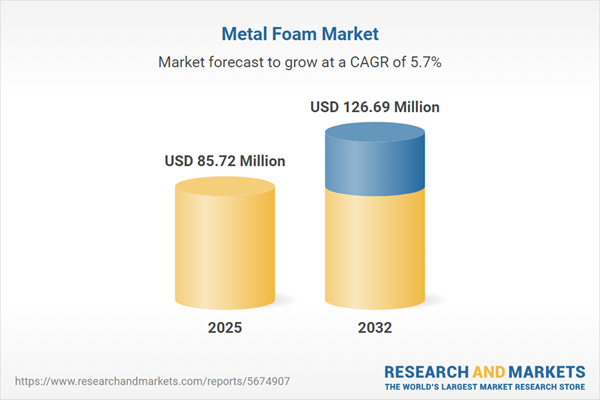Speak directly to the analyst to clarify any post sales queries you may have.
The global metal foam market empowers organizations to achieve strategic resilience through sustainable, lightweight, and regulatory-compliant solutions across advanced industrial sectors. Metal foam technologies are increasingly adopted by senior leaders intent on driving operational excellence and agile business evolution.
Market Snapshot: Global Metal Foam Market Overview
The global metal foam market demonstrates steady expansion as evolving industry requirements and sustainability directives transform advanced materials procurement. Aerospace, automotive, healthcare, and energy companies recognize metal foams as an enabler of efficiency, compliance, and innovation. Driven by surging environmental initiatives and an evolving regulatory climate, organizations are adopting metal foams into procurement and R&D strategies to reinforce operational reliability. Senior decision-makers are leveraging metal foams to adapt supply chains and enhance value propositions amid continuous regulatory and market change.
Scope & Segmentation in the Metal Foam Market
Understanding the primary metal foam market segments allows executives to target procurement, R&D, and risk management for maximum return. Each segment presents unique opportunities for customization and competitive advantage:
- Material Types: Aluminum, copper, steel, and titanium foams offer flexible combinations of low weight, mechanical strength, and corrosion resistance, serving transportation and infrastructure demands.
- Application Areas: Metal foams are vital across aerospace, automotive, construction, infrastructure, defense, electronics, energy, and healthcare, supporting efforts to raise component performance, meet compliance needs, and further sustainability targets.
- Manufacturing Methods: Gas injection, powder metallurgy, additive manufacturing, rolling, and space holder processes are utilized to enable both prototype customization and scale production according to project and application requirements.
- Cell Structures: Open-cell foams are applied where enhanced acoustic insulation or thermal management is required, while closed-cell foams provide impact resistance and robust structural performance within high-demand operational uses.
- Forms Supplied: Blocks, cylinders, panels, and particulates deliver design flexibility, integrating seamlessly into modular or large-scale industrial applications.
- Regional Markets: The Americas, EMEA, and Asia-Pacific display varied adoption, shaped by local compliance legislation, supply chain rhythms, and executives’ regional investment priorities.
- Leading Companies: ERG Aerospace Corporation, Cymat Technologies Inc., Porousferous Inc., Alantum Advanced Foam Technologies Inc., Fraunhofer-Gesellschaft, BGH Edelstahl Holding GmbH, F&S Bonding & Sealing GmbH, thyssenkrupp AG, Kawasaki Heavy Industries Ltd., and Sumitomo Electric Industries Ltd. are recognized for innovation and supply capacity.
Key Takeaways: Strategic Insights for Decision-Makers
- Metal foam adoption supports significant vehicle and infrastructure weight reduction, resulting in improved operational reliability and resource efficiency throughout supply chains.
- Digital modeling and additive manufacturing allow for accelerated development cycles, enabling organizations to address changing customer and compliance requirements with agility.
- Strengthening networks with suppliers enhances the ability to meet emergent regulatory demands and adapt to global market shifts, supporting a stable supply chain environment.
- Recycling advancements and material recovery strategies contribute towards more sustainable manufacturing and the shift toward circular production models.
- Collaborative engagement with supplier partners and industry associations helps maintain competitive positioning as technological standards develop.
- Cross-regional alignment enhances risk management capabilities and supports global expansion, aligning compliance with diverse market entry and operational priorities.
Tariff Impact: Managing Regulatory Complexity
Recent U.S. tariff policy adjustments have introduced new regulatory hurdles and price fluctuations into the global metal foam market. In response, executive leaders are prioritizing domestic production, diversifying supplier relationships, and exploring cross-regional alliances. Proactive contract and supplier management is essential to secure procurement reliability and mitigate uncertainty caused by evolving trade policies.
Methodology & Data Sources
This analysis draws from primary research, up-to-date regulatory assessments, patent investigations, and expert interviews. Senior analysts ensure all conclusions are validated, with actionable guidance tailored for executive decision-making in the global metal foam market.
Why This Report Matters
- Empowers executive teams to make informed investment and resource prioritization decisions as the metal foam market evolves.
- Supports benchmarking and compliance strategy so organizations can maintain effective procurement and adapt their innovation roadmaps for advanced materials.
- Strengthens sustainability and regional expansion efforts by guiding responses to regulatory and supply network shifts.
Conclusion
Advances in metal foam technology drive enterprise adaptability and sustainable success. Comprehensive market intelligence equips decision-makers to address regulatory shifts and harness new prospects in the advanced materials landscape.
Additional Product Information:
- Purchase of this report includes 1 year online access with quarterly updates.
- This report can be updated on request. Please contact our Customer Experience team using the Ask a Question widget on our website.
Table of Contents
3. Executive Summary
4. Market Overview
7. Cumulative Impact of Artificial Intelligence 2025
Companies Mentioned
The companies profiled in this Metal Foam market report include:- ERG Aerospace Corporation
- Cymat Technologies Inc.
- Porousferous Inc.
- Alantum Advanced Foam Technologies Inc.
- Fraunhofer-Gesellschaft zur Förderung der angewandten Forschung e.V.
- BGH Edelstahl Holding GmbH
- F&S Bonding & Sealing GmbH
- thyssenkrupp AG
- Kawasaki Heavy Industries, Ltd.
- Sumitomo Electric Industries Ltd.
Table Information
| Report Attribute | Details |
|---|---|
| No. of Pages | 196 |
| Published | November 2025 |
| Forecast Period | 2025 - 2032 |
| Estimated Market Value ( USD | $ 85.72 Million |
| Forecasted Market Value ( USD | $ 126.69 Million |
| Compound Annual Growth Rate | 5.7% |
| Regions Covered | Global |
| No. of Companies Mentioned | 11 |









